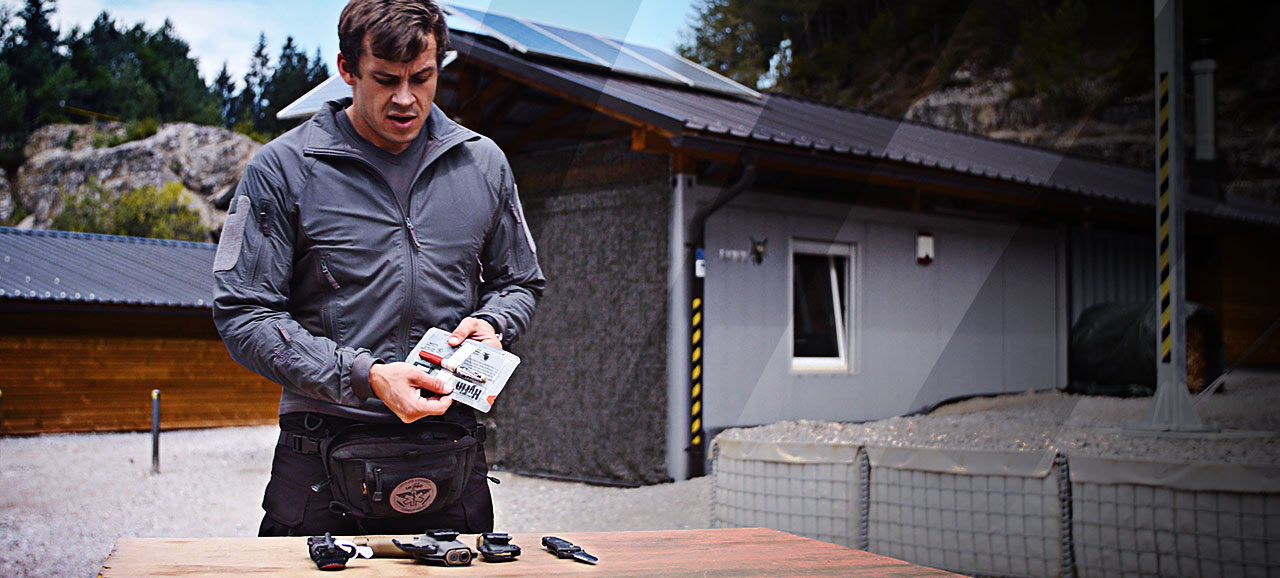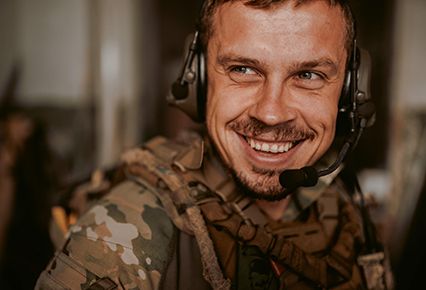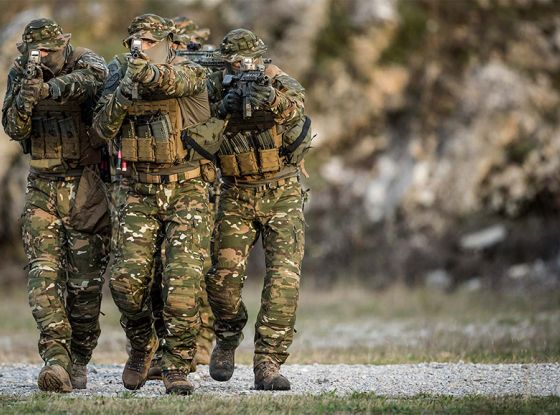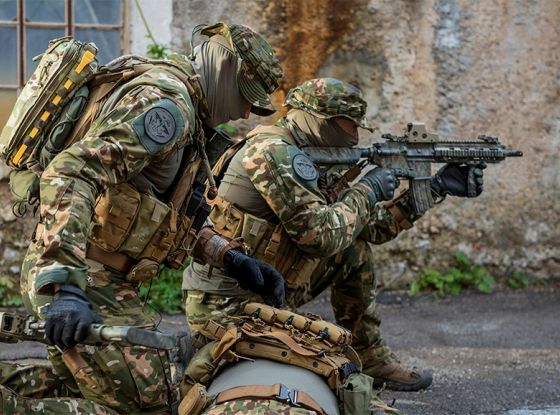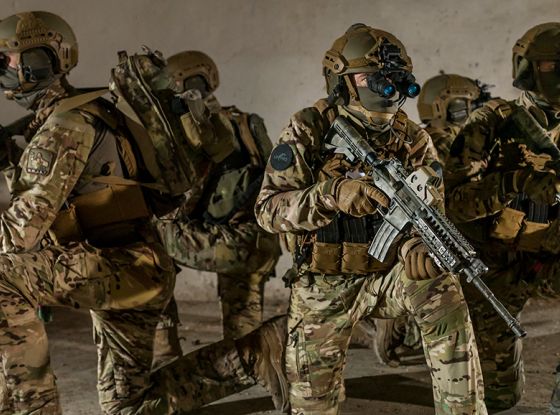Unsure about which essential medic gear to pack for everyday scenarios in civilian life? Find out in this blog post written by a former SF Combat Medic. He reveals the contents of the medical kits he typically carries on his person, in his car, and out at the shooting range—plus he shares what goes into his secret “BeepBeep bag”.
What’s in this Blog post?
Personal EDC medic bag
This is what I carry when I’m on a date or just out slaying some beers. As you can see, I like to go light and minimal. I know these ankle kits are popular, but there’s something you need to be aware of about them.
Whether you’re coming from the Balkans or from Detroit, this super-duper kit can be easily mistaken for an ankle monitor (which tends to attract unwanted attention from the cops and it can make someone you’re taking out on a first date suspicious of you, ruining your prospects in the process).
My bare minimum: a tourniquet (or at least the know-how to improvise one in the event carrying around a TQ is impractical). The reason I recommend a TQ as the bare minimum is that, even in a “normal” urban setting, help in the form of an ambulance or a doctor could be many long minutes away from reaching you—and in situations calling for a TQ, seconds count.
Here’s my list of what I carry for dealing with everyday scenarios:
- TQ (tourniquet)
- Combat gauze
- Small, emergency bandage
- Chest seal with NCD (needle chest decompression)
- NPA ( nasopharyngeal airway) with surgical lubricant
We can also add:
- Flashlight (optional, depending on whether you need more than a cellphone’s illumination)
- Power bank
- Gun and ammo
- Knife
- Extra cash and coins
Basically, anything else you can think of to make your life on the go easier and be prepared for awkward situations; just make sure you don’t add so much stuff that you’re no longer able to move)
You can store these essentials in either an ankle bracelet or a fanny pack (although a fanny pack practically screams “I’m a dad” or “I’m an operator,” so maybe try to disguise yourself as a dad). Possibly the better option is to use a backpack, which I highly recommend.
Car EDC medic bag
Driving around in your car, you never know when you’ll happen upon a traffic accident. Or if you’ll be stuck in traffic. Or if you’ll be caught in the middle of a riot and surrounded by looters (okay, just kidding about this last one).
Still, you have a duty to be a responsible person while driving, which means you have to be prepared for medical emergencies encountered on the road.
But, at the same time, you can’t pack your vehicle with so much medical equipment that you have no room to squeeze into the driver’s seat. You can’t overload with medical supplies, expecting to quickly turn into Mad Max and be able to face the apocalypse.
In other words, don’t be that guy with the sign that reads “the end is near” and think you have to be prepared for everything.
You really don’t need all that much in your vehicle, assuming you’re in a functioning country that isn’t war-torn and where paramedics can quickly arrive at the scene. Just carry the trauma basics, the items that save lives— and let your country's laws and your own scope of practice guide your choices.
Generally, though, you can’t go wrong following the KISS method—KISS stands for “keep it simple, stupid.”
Here’s my list of medical essentials to keep in the car:
- Basic trauma set with a TQ on top of the bag
- First-aid kit
- Empty gasoline can (so when your car runs out of fuel in the middle of nowhere you can feel the shame of walking to the nearest service station to fetch the gas that you forgot to purchase before you started your trip)
- Bottles of water
- Duct tape
- Extra clothes (for preventing hypothermia)
- Sleeping bag (plus a couple of emergency “space” blankets)
- Scissors
- Multitool
- Headlamp
- Chemlights
- Visabilty vest
- Essential “BeepBeep bag”
- Opitonal: A “BeepBeep” bag
- Optional: toilet paper (especially if there’s an ongoing pandemic)
- Optional: food(that can last a long time)
The basic trauma set up is a tourniquet kept on top of the bag. If your car has a pouch or a container attached to the interior side of the driver’s door, put these medical items there.
You also need to carry in your vehicle a first-aid kit that’s always at the ready. Not a bad idea, too, to have an empty gas can plus a couple of liters of bottled water along with duct tape and toilet paper (this last item just in case there’s another pandemic outbreak).
I also keep in my car some added stuff that comes handy.
For example, your car might break down in the middle of nowhere in the dead of a cold night. Having extra clothes and an emergency “space” blanket available can keep you warm until help arrives. Or, if you’re dealing with someone who has hypothermia, those items of clothing and the blanket could be lifesavers.
Shooting-range EDC medic bag
As a responsible member of the public, you should be prepared for accidents on the shooting range.
Accidents do happen on the range. Just think of how many times you’ve seen someone there who’d be better off shooting a Nerf gun rather than an actual gun. People like that tend to shoot themselves in the foot or leg—and it happens because they are irresponsible and careless, thinking they’re handling a toy and that this is all a game.
Well it’s not a game and those aren’t toys. Consequently, I recommend having an everyday medical kit for the shooting range.
Because the shooting range is a place where lots of bad stuff can happen, it’s most important that your medical kit contains items sufficient to let you deal with almost any trauma scenario.
Here’s my list for the essential EDC range gear:
- Basic first-aid kit that covers trauma (check out our combat medical essentials video series for more intel on this)
- Tourniquet
- Emergency bandage
- Combat gauze
- Nasopharyngeal airway with surgical lubricant
- Chest seals
- Space blanket
- Multiple additional items can be added to this setup, depending on your needs and your country's laws
- Needle chest decompression
- EpiPen (epinephrine auto-injector)
- ACE bandages
- And whatever else that works for your specific needs (while my kit works for me, it might not work for you)
- A “BeepBeep bag” (because it’s more likely you’ll need to treat a headache rather than catastrophic bleeding)
“BeepBeep bag” EDC medic bag
A lot of people ask, what is a “BeepBeep bag”? Ask and you shall receive—that’s our motto.
A “BeepBeep bag” contains items that let you deal with painful and embarrassing injuries, especially those you bring upon yourself by doing dumb shite.
Here’s my list:
- Good-quality gel Band-Aid brand adhesive bandages (for blisters)—optional: get the kind imprinted with the Batman comic-book character (shows you’re a tough guy who can handle pain)
- Isopropyl alcohol (for cleansing wounds and sterilizing your hands)
- Quality gauze bandages (for dressing wounds)
- Pill or liquid medications for relief of pain, fever, allergies, and sore throat
- Sunscreen
- Electrolyte solution (to aid in rehydration)
- Chocolate bar (for energy and comfort)
All of these items are good to have handy, but don’t sweat it if any are missing from your “BeepBeep bag”—you’ll live.
Even so, keep in mind that, in the eyes of the commander, a well-stocked “BeepBeep bag” is what separates the good medics from the bad ones: you can be the best medic in the world, but to the chief you’re worthless if you can't cure a headache.

